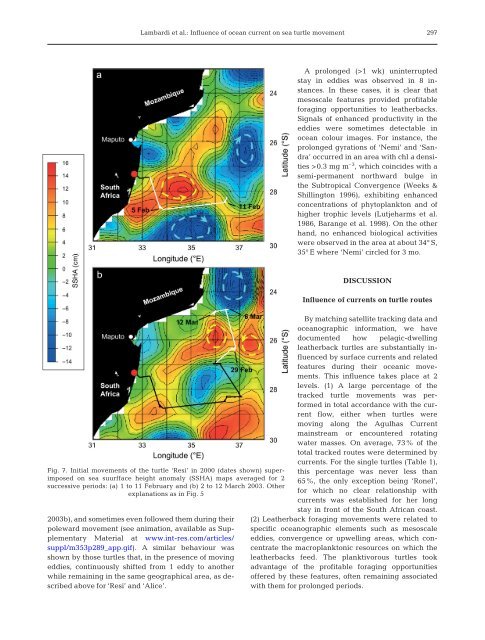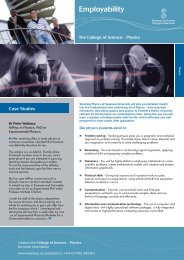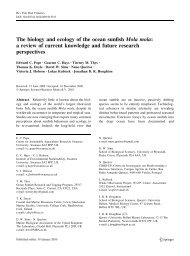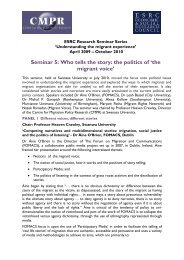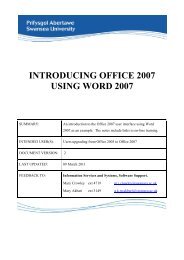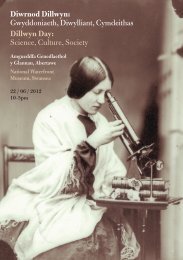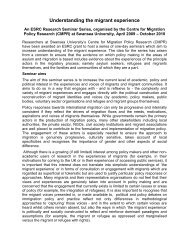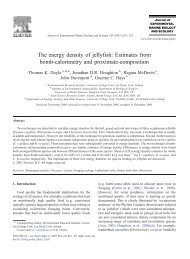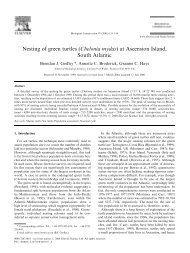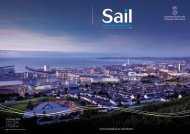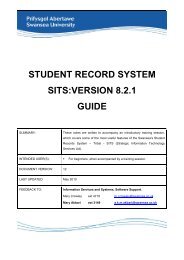Marine Ecology Progress Series 353:289
Marine Ecology Progress Series 353:289
Marine Ecology Progress Series 353:289
You also want an ePaper? Increase the reach of your titles
YUMPU automatically turns print PDFs into web optimized ePapers that Google loves.
Lambardi et al.: Influence of ocean current on sea turtle movement<br />
297<br />
A prolonged (>1 wk) uninterrupted<br />
stay in eddies was observed in 8 instances.<br />
In these cases, it is clear that<br />
mesoscale features provided profitable<br />
foraging opportunities to leatherbacks.<br />
Signals of enhanced productivity in the<br />
eddies were sometimes detectable in<br />
ocean colour images. For instance, the<br />
prolonged gyrations of ‘Nemi’ and ‘Sandra’<br />
occurred in an area with chl a densities<br />
>0.3 mg m –3 , which coincides with a<br />
semi-permanent northward bulge in<br />
the Subtropical Convergence (Weeks &<br />
Shillington 1996), exhibiting enhanced<br />
concentrations of phytoplankton and of<br />
higher trophic levels (Lutjeharms et al.<br />
1986, Barange et al. 1998). On the other<br />
hand, no enhanced biological activities<br />
were observed in the area at about 34° S,<br />
35° E where ‘Nemi’ circled for 3 mo.<br />
Fig. 7. Initial movements of the turtle ‘Resi’ in 2000 (dates shown) superimposed<br />
on sea suurfface height anomaly (SSHA) maps averaged for 2<br />
successive periods: (a) 1 to 11 February and (b) 2 to 12 March 2003. Other<br />
explanations as in Fig. 5<br />
2003b), and sometimes even followed them during their<br />
poleward movement (see animation, available as Supplementary<br />
Material at www.int-res.com/articles/<br />
suppl/m<strong>353</strong>p<strong>289</strong>_app.gif). A similar behaviour was<br />
shown by those turtles that, in the presence of moving<br />
eddies, continuously shifted from 1 eddy to another<br />
while remaining in the same geographical area, as described<br />
above for ‘Resi’ and ‘Alice’.<br />
DISCUSSION<br />
Influence of currents on turtle routes<br />
By matching satellite tracking data and<br />
oceanographic information, we have<br />
documented how pelagic-dwelling<br />
leatherback turtles are substantially influenced<br />
by surface currents and related<br />
features during their oceanic movements.<br />
This influence takes place at 2<br />
levels. (1) A large percentage of the<br />
tracked turtle movements was performed<br />
in total accordance with the current<br />
flow, either when turtles were<br />
moving along the Agulhas Current<br />
mainstream or encountered rotating<br />
water masses. On average, 73% of the<br />
total tracked routes were determined by<br />
currents. For the single turtles (Table 1),<br />
this percentage was never less than<br />
65%, the only exception being ‘Ronel’,<br />
for which no clear relationship with<br />
currents was established for her long<br />
stay in front of the South African coast.<br />
(2) Leatherback foraging movements were related to<br />
specific oceanographic elements such as mesoscale<br />
eddies, convergence or upwelling areas, which concentrate<br />
the macroplanktonic resources on which the<br />
leatherbacks feed. The planktivorous turtles took<br />
advantage of the profitable foraging opportunities<br />
offered by these features, often remaining associated<br />
with them for prolonged periods.


